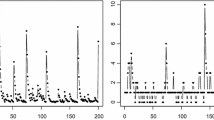Abstract
We give the cumulative distribution function of M n , the maximum of a sequence of n observations from an autoregressive process of order 1. Solutions are first given in terms of repeated integrals and then for the case, where the underlying random variables are absolutely continuous. When the correlation is positive,
where
where {ν jx } are the eigenvalues of a non-symmetric Fredholm kernel, and ν 1x is the eigenvalue of maximum magnitude. When the correlation is negative
The weights β jx depend on the jth left and right eigenfunctions of the kernel. These are given formally by left and right eigenvectors of an infinite Toeplitz matrix whose eigenvalues are just {ν jx }. These results are large deviations expansions for extremes, since the maximum need not be standardized to have a limit. In fact, such a limit need not exist. The use of the derived expansion for P(M n ≤ x) is illustrated using both simulated and real data sets.
Similar content being viewed by others
References
Abramowitz M, Stegun IA (1964) Handbook of mathematical functions. US Department of commerce, National bureau of standards, Appl Math Ser, vol 55
Borkovec M (2000) Extremal behavior of the autoregressive process with ARCH(1) errors. Stochastic Processes Appl 85: 189–207
Chernick MR, Davis RA (1982) Extremes in autoregressive processes with uniform marginal distributions. Stat Probab Lett 1: 85–88
Elek P, Zempléni A (2008) Tail behaviour and extremes of two-state Markov-switching autoregressive models. Comput Math Appl 55: 2839–2855
Horn RA, Johnson CR (1985) Matrix analysis. Cambridge University Press, New York
McCormick WP, Park YS (1992) Asymptotic analysis of extremes from autoregressive negative binomial processes. J Appl Probab 29: 904–920
McCormick WP, Mathew G (1989) Asymptotic results for an extreme value estimator of the autocorrelation coefficient for a first order autoregressive sequence. In: Extreme value theory (Oberwolfach 1987), Lecture notes in statistics, vol 51. Springer, New York, pp 166–180
Nadarajah S (2005) Extremes of daily rainfall in west central Florida. Climatic change 69: 325–342
Nadarajah S, Mitov K (2002) Asymptotics of maxima of discrete random variables. Extremes 5: 287–294
Ol’shanskii KA (2004) On the extremal index of a thinned autoregression process. (Russian) Vestnik Moskovskogo Universiteta. Seriya I. Matematika, Mekhanika 70:17–23. Translation in Moscow University Mathematics Bulletin 59:18–24
Withers CS (1974) Mercer’s theorem and Fredholm resolvents. Bull Aust Math Soc 11: 373–380
Withers CS (1975) Fredholm theory for arbitrary measure spaces. Bull Aust Math Soc 12: 283–292
Withers CS (1978) Fredholm equations have uniformly convergent solutions. J Math Anal Appl 64: 602–609
Withers CS, Nadarajah S (2008) Fredholm equations for non-symmetric kernels with applications to iterated integral operators. Appl Math Comput 204: 499–507
Withers CS, Nadarajah S (2009) The distribution of the maximum of a first order moving average: the continuous case. Technical Report, Applied mathematics group, Industrial Research Ltd., Lower Hutt, New Zealand
Author information
Authors and Affiliations
Corresponding author
Rights and permissions
About this article
Cite this article
Withers, C.S., Nadarajah, S. The distribution of the maximum of a first order autoregressive process: the continuous case. Metrika 74, 247–266 (2011). https://doi.org/10.1007/s00184-010-0301-0
Received:
Published:
Issue Date:
DOI: https://doi.org/10.1007/s00184-010-0301-0




